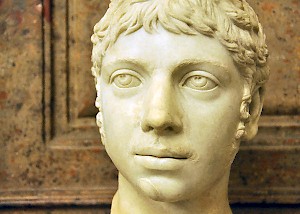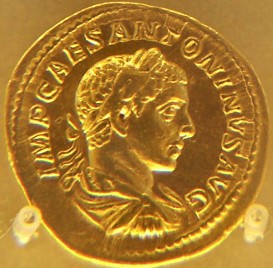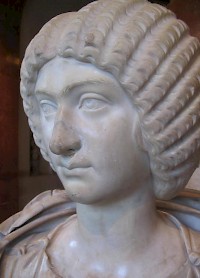Heliogabalus' Religion (2)
Heliogabalus: emperor of Rome, ruled from 218 to 222, famous for his religious reforms and the introduction of the cult of the Syrian sun god Elagabal.
Religious policy (part 2)
Truthfulness of accusations

Cultic acts such as temple prostitution, castration, and (perhaps) human sacrifice were part of the Semitic world to which the cult of Sol Invictus Elagabal belonged. It is plausible that our ancient sources have misunderstood these practices and used them to make the emperor look more horrifying.
If these cultic acts were indeed performed by the emperor, the question remains how these acts should be connected to the cult in general. As has been noted before, temple prostitution was connected to the cult of one particular goddesses. The same can be said for castration. But what is the big picture?
It has been assumed that there was a general tendency towards monotheism in the third century, and if one believes this, one can also discern this tendency in Heliogabalus' religious reforms. It is even possible to think that the cult of Sol Invictus Elagabal exerted much influence on Roman religious life from the third century and onwards. However, most scholars believe that Heliogabalus was not the architect of monotheism. Other gods were worshipped in Emesa as well and, as we have seen, Heliogabalus did not ignore them. The accusation that the emperor wished to destroy all other gods in order to venerate only his own god cannot be defended.

Henotheism is another approach to the cult of Sol Invictus Elagabal: only one god existed and all other gods were incorporated in this one deity. However, many inscriptions with dedications to other gods as well as images are known from Emesa.
Again, the oriental evidence may offer a solution. In the east, it was not uncommon that one god was the chief and other gods followed him in an hierarchical order, as if they were part of the supreme god's household, each with a different status. Eastern astronomers perceived the sun as Basileus Hêlios surrounded by his servants who regulated the celestial bodies. Heliogabalus may have wished to introduce this concept in Rome as well. This may explain why several altars were placed around the temple of Sol Invictus.
Heliogabalus must have considered himself a pious man although he wasn't depicted this way in ancient sources. The difference in opinion can be explained. An Arab calendar survives in which the religious teachings and cultic ceremonies of the ancient Semitic religions have been described. It sheds much light on the cult of Sol Invictus Elagabal as well as on the acts of Heliogabalus. When one looks at this calendar, one will understand that the emperor as high priest was constantly occupied by the demands of his god, who left his servant no time for state affairs. The emperor-priest lived his life according to the godly arrangement of time. In fact, he had no time left to explain his acts to his citizens, which must have cause many misunderstandings.
Spread and Influence of the Cult in Rome
Enough has now been said of the cult of Sol Invictus Elagabal as well as the reign of Heliogabalus, the major propagator of this cult. This section will focus on the questions as to how Sol Invictus came to be known to the Romans and if his influence was lasting. Several scholars believe that the cult came to Rome through the agency of Heliogabalus and left the city as soon as he was killed. In other words, the cult in Rome was an ephemeron. On the other hand, epigraphical evidence proves otherwise and there is something to be said for the idea that the cult was an answer to a crisis in the classical religions, a crisis that is also documented by the rise of charismatic teaching.
On the question as to how the Romans got into touch with the cult of Sol Invictus Elagabal, two contributing factors must be mentioned. First of all, there was a great concentration of troops in Syria. The soldiers of III Gallica worshipped Elagabal. A second factor was the increasing commerce between East and West, which conveyed ideas along with products.
Solar deities such as Sol Invictus already occupied an important position in the second century. This is well illustrated by an inscription from the Roman fort Laurum in Germania Inferior (Woerden in present-day Holland), where an auxiliary soldier dedicated a votive altar to Elagabal during the reign of Antoninus Pius (138-161).

During the reign of the emperor Septimius Severus (193-211), the founder of Heliogabalus' dynasty, there was no escaping eastern religion. Septimius came into contact with eastern philosophers in Emesa and studied the writings and sermons of Sol Invictus Elagabal. He married a Syrian lady with the same constellation as he, because this had been ordained by a horoscope.

This lady woman was Julia Domna, the daughter of high priest Julius Bassianus of Emesa. She brought her customs and religion with her to Rome. From now on, the imperial family propagated the cult of Sol Invictus. More and more Syrians came to Rome and occupied high offices (Herodian may have been among them). Caracalla followed his father's lead by expressing his wish for a single religious faith and cult, universally accepted. In the end, this plan was executed by Heliogabalus.
It has been assumed that there was a master plan: Heliogabalus and his grandmother Julia Maesa, the sister of Julia Domna, used their imperial power to raise the imperial cult to a more philosophical level. It is indeed tempting to see Julia Maesa as the master brain behind the regaining of her family's throne. However, it is less certain that she was also behind the religious policy, which she has also sought to temper. In any case the attempts to actively propagate the cult of the sun god were too rash, premature, and not thoroughly thought through. Still, the cult remained popular in the third century and was not wiped out after Heliogabalus' death.
The oldest evidence for the worship of Sol Invictus, as we have already seen, is a dedication from Woerden. Another early example is a dedication by Publius Aelius Amandus, a member of the mounted bodyguard of the emperor. The little monument was erected in 158 and consisted of a small marble altar bearing a depiction of the sun god. The epigraphic evidence also includes inscriptions by men of some importance. The cult was not only known, but also attracted devotees of a higher status. This is exactly what could be expected. The cult must have been known well before Heliogabalus' arrival, due to his "grandfather" Septimius Severus and his wife Julia Domna. It seems unlikely that Julia Domna, Julia Maesa and their half Syrian court would just forget their roots and religion.
The penetration of the Sol Invictus Elagabal cult under the reign of Heliogabalus may have been rash and intense. Heliogabalus may have been quiet during the first two years of his reign, but from 220 there was to be no mistake as to which god stood first in line. Sol Invictus Elagabal was placed above Jupiter and the emperor was his sacerdos amplissimus. Two temples were dedicated to the god and in 220 and 221, there was a grand festival in his honor. Every day Heliogabalus would sacrifice a hecatomb and old wine to his god during a musical, exotic procession. Many people would attend these sacrifices, including representatives of the Roman nobility, although they may not have done so willingly.
The cult played an important role in everyday Roman life because it was the emperor who had imposed it upon his people. It did not completely disappear after his death, but it was less visible than it had been before because its main propagator had been condemned with the damnatio memoriae.